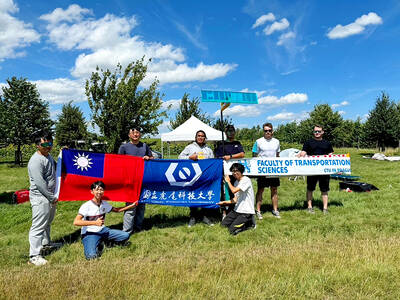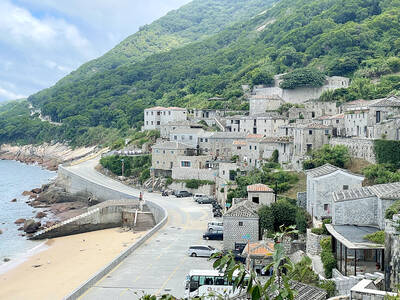Overloading caused the crash of a helicopter that the army transferred to the National Fire Administration (NFA) as part of the Alishan train crash rescue operation, an army investigation has concluded.
The UH-1H chopper was capable of carrying nine people, or 427.5kg, but it took as many as 15 people, the report said.
The pilot of the helicopter apparently did not follow the weight limits for the UH-1H, which varies according to flight altitude, it said.
The army identified the cause of the crash, partly because it does not want to become a scapegoat for the incident. It also said it was willing to make public part of the results of the report.
Following the crash of the UH-1H last Saturday, the public initially pointed to the army rather than the NFA, as it was then suspected that the army might have dumped unwanted helicopters on the NFA.
The army transferred a total of 23 helicopters, including 20 UH-1Hs and three B-234s, to the NFA last year for use by the administration's newly established airborne rescue and fire-fighting unit.
The army denied allegations that the UH-1Hs, though in service for around three decades, are too old to be counted on for difficult missions and that the helicopters it gave to the NFA were retired ones.
To defend itself against the accusations, the army launched its own investigation and found the incident was caused not by mechanical problems but by human factors.
"The pilot was not ignorant of the limits. He might have skipped the pre-flight briefing, in which he should have been informed of the weight limits for the helicopter he was to fly to Alishan," said an army official, who declined to be identified.
"Without the briefing, the pilot was more likely to make some mistakes, despite his experience," the official said.
"For the usage of UH-1Hs, the army has a way of figuring out different weight limits for the helicopters at different altitudes. Such data would have been provided in the pre-flight briefing," he said.
"The UH-1H that crashed on March 1, was capable of carrying just nine people or 950 pounds of load, at the time of the mission. The nine persons included three crew members. The actual number of people that the helicopter was capable of carrying should have been six," he said.
"It is also dangerous to use helicopters for high-altitude rescue missions. Because of thin air at high altitudes, helicopters run the risk of losing power in the execution of rescue missions," the official said.
"A better and safer solution is to use fixed-wing aircraft for rescue or fire-fighting missions at higher altitudes. But it will surely cost more money," he said.

The Chinese military has built landing bridge ships designed to expand its amphibious options for a potential assault on Taiwan, but their combat effectiveness is limited due to their high vulnerability, a defense expert said in an analysis published on Monday. Shen Ming-shih (沈明室), a research fellow at the Institute for National Defense and Security Research, said that the deployment of such vessels as part of the Chinese People’s Liberation Army (PLA) Navy’s East Sea Fleet signals a strong focus on Taiwan. However, the ships are highly vulnerable to precision strikes, which means they could be destroyed before they achieve their intended

The Taiwan Experience Education Program (TEEP) has funded short-term internships in Taiwan for more than 4,500 young people from more than 40 countries since 2015, with the goal of attracting and retaining international talent, the Ministry of Education said yesterday. Fifty-five colleges launched 514 projects this year, including in fields such as semiconductors, artificial intelligence, medicine and biotechnology, green energy, and sustainability, it said. The program provides research and practical internships in Taiwan for two to six months, and offers cultural exchange and networking opportunities, the ministry said. For example, National Formosa University’s Embedded System and Autopilot Laboratory developed two solar-powered drones in

GLOBAL: Although Matsu has limited capacity for large numbers of domestic tourists, it would be a great high-end destination for international travelers, an official said Lienchiang County’s (Matsu) unique landscape and Cold War history give it great potential to be marketed as a destination for international travelers, Tourism Administration Director General Chen Yu-hsiu (陳玉秀) said at the weekend. Tourism officials traveled to the outlying island for the Matsu Biennial, an art festival that started on Friday to celebrate Matsu’s culture, history and landscape. Travelers to Matsu, which lies about 190km northwest of Taipei, must fly or take the state-run New Taima passenger ship. However, flights are often canceled during fog season from April to June. Chen spoke about her vision to promote Matsu as a tourist attraction in

Taipei resident Mu Chu-hua caught some glimpses of China’s mighty military parade on YouTube on Wednesday. As she watched hypersonic missiles roll down Beijing’s Changan Avenue and troops march in lockstep, she did not feel like they posed a threat to Taiwan. Mu, a 69-year-old retiree, said she saw the parade as simply a way for Chinese President Xi Jinping (習近平) to “say thank you to the troops.” “I thought it was quite normal,” she said. “It was very cool.” China’s military parade commemorating the end of World War II was being watched internationally for insights into Beijing’s military advances and its show